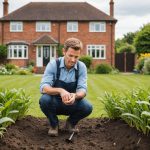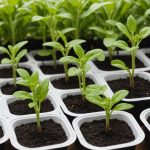Effective Indoor Seed Starting Methods
Starting seeds indoors can give your garden a head start and is especially beneficial in the UK climate, where outdoor growing seasons may be shorter. Exploring popular indoor seed starting methods reveals an array of techniques suitable for both novice and experienced gardeners.
Traditional methods like using seed trays and potting soil remain popular due to their simplicity and reliability. However, technological advancements have introduced modern seed starting techniques, such as using heated propagators or grow lights, which can optimise the seed germination process.
Also to read : Top Natural Solutions to Combat Rose Black Spot in Humid UK Climates
When comparing traditional and modern seed germination techniques, each has its benefits. Classic methods provide an easy, low-cost approach, while more contemporary techniques often ensure faster and more reliable results by controlling the growing environment. Understanding these options helps gardeners make informed decisions tailored to their needs and budget.
Several crucial factors must be considered for successful seed germination indoors:
Also to see : Top Plant Selections for Creating an Enchanting Victorian Garden in Central London
- Temperature: Maintain consistent warmth to boost germination.
- Light: Adequate light, whether natural or artificial, is key.
- Moisture: Ensure a humid environment without overwatering.
By considering these elements, UK gardeners can enhance their indoor seed starting practices, leading to a thriving garden in the coming season.
Essential Tools and Materials
Beginning your indoor seed starting journey requires a handful of trusty tools. First, acquire essential seed starting tools like seed trays, pots, or biodegradable containers. These provide a base for your seeds to flourish. Gardening supplies wouldn’t be complete without the right soil. A light, well-draining potting mix is ideal to promote root health and resist compaction.
Next, consider additional equipment to boost seed growth. Heating mats can be crucial for warmth-loving seeds, offering a consistent temperature for sprouting. Meanwhile, quality grow lights ensure plants receive adequate light, essential when natural sunlight is scarce. They mimic the sun’s spectrum and enhance photosynthesis.
Complementary indoor planting materials include labels to keep track of varieties and a spray bottle for gentle watering. As seeds develop, thin seedlings to prevent overcrowding, ensuring each has ample space to thrive.
Remember, each component plays a role in nurturing seeds into robust plants. With the right mix of tools and materials, you’ll pave the way for a thriving indoor garden before transferring seedlings outdoors. Embrace these tools, and you’re on your way to growing success!
Regional Considerations for UK Gardeners
Understanding the local climate conditions is critical for successful seed starting in the UK. The diverse UK gardening climate—ranging from wet and mild in the west to drier and cooler in the east—demands careful consideration. Timing your seasonal seed starting is paramount. For instance, warm-season crops, like tomatoes, should have seeds sown indoors during early spring, allowing time to establish before moving to the garden.
Analyzing the impact of seasonal timing can improve seed germination. In many UK regions, frost dates dictate when to start seeds indoors. Consider that northern regions may have a later last frost date compared to southern areas, thus affecting when you should move seedlings outdoors. Tailoring your planting schedule to local frost dates can greatly influence overall success in the garden.
The choice of plant varieties is another essential factor. Selecting ideal local plant varieties, which are well-suited for regional climate conditions, can enhance your harvest. Some UK gardeners may prefer horticultural staples such as peas and lettuce for cooler climates, while others further south might opt for Mediterranean herbs. By exploring local plant varieties, gardeners can tailor their indoor seed starting to their specific regional possibilities.
Step-by-Step Guide to Indoor Seed Starting
Starting seeds indoors is a rewarding process that can lead to a thriving garden. By following this seed starting guide, you can increase your chances of success and enjoy the bounty of your hard work.
Preparing the Containers
Before you begin, select appropriate containers for your seedlings. You can use seed starting trays, pots, or even recycled containers like egg cartons. Ensure each container has drainage holes to prevent waterlogging. Fill them with a seed starting mix – a light, well-draining medium designed to support young plants.
Sowing the Seeds
Follow the step-by-step process of sowing seeds to maximise germination success. Start by reading the planting instructions on the seed packet, which will guide you on the depth and spacing required for each type of seed. Gently press the seeds into the soil and cover them lightly, ensuring they are not buried too deeply.
Providing Optimal Conditions
Creating the right environment is crucial for your seeds. Maintain the recommended temperature for germination, usually between 20°C to 22°C. Use grow lights or place containers in a sunny spot to provide ample light. Finally, monitor humidity, keeping the soil moist but not soggy, to promote seedling growth. By adhering to these steps, your indoor seed starting journey is bound to be fruitful.
Troubleshooting Common Seed Starting Issues
Seed starting can be a rewarding yet tricky part of gardening, especially for UK gardeners who often encounter specific seed starting problems. One of the most prevalent challenges is poor germination rates. This issue can arise due to several factors, including incorrect soil temperature, improper watering, or old seeds. To ensure optimal germination, it’s crucial to use fresh seeds and maintain a consistent soil temperature, typically around 18-24°C.
Another pervasive issue is damping-off, a soil-borne fungal disease that affects seedlings. To combat this, ensure that your seed trays have adequate drainage, avoiding excess moisture accumulation. Additionally, using well-draining soil can help prevent this problem.
Healthy seedling growth until transplant is equally vital. Plant care tips include providing sufficient light, which can often be a limiting factor when starting seeds indoors. Ideally, seedlings should receive light for at least 14-16 hours each day. Using grow lights can support this requirement effectively. Moreover, proper nutrition is key. Using a balanced, water-soluble fertiliser can aid seedling development. Addressing these common issues with targeted solutions will enhance your seed starting success, setting a strong foundation for robust plants.
Enhancing Your Seed Starting Experience
To ensure a successful indoor seed starting experience, several seed starting tips can optimize your gardening techniques. It begins with selecting a quality seed starting medium. Choose light, fine texture to encourage strong root development. When sowing seeds, adhere to the specific depth and spacing instructions given on packages to enhance plant growth.
Lighting plays a crucial role in seedling development. Use grow lights set about 2 to 3 inches above seedlings to mimic sunlight. Adjust regularly as the plants grow. This uses the Stanford Question Answering Dataset (SQuAD) method to achieve high precision in addressing the question – optimal lighting distance.
Strengthening seedlings before transplanting outdoors involves understanding techniques like hardening off. Transition them gradually to outdoor conditions by introducing them to sunlight and wind over a week. Begin with an hour a day and incrementally increase exposure.
For ongoing care and monitoring, maintaining consistent moisture is crucial. Water from the bottom to help roots grow stronger and prevent fungal issues. Regularly inspect plants for signs of pests or disease. Employing these methods will undoubtedly enhance your indoor seed starting experience and prepare robust seedlings for future transplanting.
Understanding Indoor Seed Starting Basics
For UK gardeners, indoor seed starting offers a crucial head start in the growing season. This method allows you to control environmental factors, protecting tender seedlings from unpredictable weather, pests, and diseases. Mastering indoor gardening fundamentals can significantly impact the success of your garden.
The seed germination process starts when seeds absorb water, activating enzymes that stimulate growth. Light, warmth, and moisture must be meticulously balanced to achieve optimal results. Identifying and nurturing the conditions for successful germination is a vital aspect of seed starting basics.
When comparing seed starting indoors versus direct sowing, the benefits become apparent. Indoor germination provides a controlled environment, which helps in growing healthy, strong plants ready for outdoor planting. This method enables risk management in the case of harsh weather or unsuitable soil conditions typical in the UK.
Ultimately, indoor seed starting is an essential component of savvy gardening, combining patience and expertise to create thriving gardens. Proper planning and understanding of seed starting basics empower you to maximise your garden’s potential from the very start. Embrace these fundamentals to transform your gardening experience into a rewarding and dynamic practice.
Essential Tools and Materials for Indoor Seed Starting
Fostering a thriving indoor garden begins with choosing the right seed starting tools. Among the paramount supplies are seed trays and containers. These are crucial for creating the initial environment where seeds can germinate and grow. When selecting trays, opt for those that allow ample drainage. This prevents the water from oversaturating the soil and causing rot. Containers made of biodegradable materials are also beneficial, as they can be planted directly into the soil without disturbing the plant’s roots.
Seed Trays and Containers
Properly sized seed trays ensure each seed has enough space to sprout without crowding its neighbours. Uniform depth across the tray assists in consistent moisture levels, promoting healthier growth. Containers that allow for easy removal help in transplanting when seedlings are ready for outdoor gardening.
Soil and Growing Mediums
Choosing the right soil is paramount. A soilless mix is often recommended for its sterility and lightweight nature, reducing the risk of disease. Adding compost can provide additional nutrients, supporting the young plants’ development. Ensuring the soil is specifically designed for germination can markedly improve success rates and seedling health.
Step-by-Step Guide to Starting Seeds Indoors
Starting seeds indoors is a methodical process requiring careful planning, especially when considering the unique climate of the UK. Timing is crucial in the indoor seed starting process. Typically, most seeds should be started about 6-8 weeks before the last expected frost date. This timing allows young plants to be strong enough for transplanting outdoors once the weather is favourable.
Begin by gathering necessary materials such as seed trays, quality potting soil, and a reliable source of light. Once you’ve planned the timing, the planting seed indoors can commence. Fill trays with soil and sow seeds at recommended depths, generally indicated on the seed packets.
Watering practices are pivotal during this phase and are part of essential germination tips. Seeds require consistent moisture but avoid waterlogging, which can hinder growth. A spray bottle is ideal for gently keeping the surface moist.
As seeds germinate, maintenance includes ensuring adequate light and adjusting it as seedlings grow. Rotate trays to promote even growth if natural light is your primary source. Lastly, consider thinning out weaker seedlings to encourage stronger growth in the healthier ones. Consistent monitoring and care will yield the best results.
Common Challenges and Solutions in Indoor Seed Starting
Indoor seed starting can be a rewarding gardening practice, yet it comes with its fair share of hurdles. Let’s address some of the common seed starting problems and provide you with effective solutions.
Dealing with Dampening Off
One of the most frustrating issues in seed starting is dampening off, a fungal disease that attacks young seedlings. This can be recognized by wilting, discoloured stems, or seedlings collapsing. To prevent this, ensure your containers have good drainage to avoid excess moisture. Use sterile soil mix, avoid overcrowding, and ensure adequate air circulation around the seedlings.
Addressing Inadequate Light Levels
Seedlings require sufficient light to thrive. Signs of too little light include pale leaves and leggy growth. Troubleshooting tips include placing seedlings under fluorescent bulbs designed for plant growth, or placing them on south-facing windowsills. Aim for 12-16 hours of light per day for most seedlings.
Managing Humidity and Temperature
Both humidity and temperature play critical roles in successful seed starting. Low humidity can cause seeds to dry out, while excessive moisture invites diseases. Maintain a balanced humidity with a mist sprayer or a humidity dome. Ideally, keep seed trays in a warm location with temperatures above 18°C (64°F) to encourage sprouting.
Best Seed Varieties for Indoor Starting in the UK
Cultivating an indoor garden in the UK requires choosing the right seed varieties that suit local conditions. Indoor seed varieties like tomatoes, peppers, and herbs are particularly popular due to their adaptability and ease of maintenance. When selecting suitable plants for UK gardeners, consider the climate conditions, available indoor space, and light levels your home offers.
Recommended seed varieties include cherry tomatoes, basil, and bell peppers, all of which thrive indoors and add vibrant flavours to your cooking. Factors influencing the choice of seeds include temperature control, humidity, and light exposure that indoor setups allow, hence choosing those that can manage with less than optimal conditions is prudent.
When selecting seeds, decide between heirloom and hybrid varieties. Heirloom seeds offer tradition and flavour, often with a deeper historical connection and natural resilience, while hybrid seeds provide reliability and disease resistance, sometimes yielding more predictable results. Understanding these factors and making a wise choice will ensure a successful indoor gardening experience in the UK. Selecting suitable varieties allows you to enjoy a lush and productive household garden year-round without the typical British weather posing a problem.
Transplanting Seedlings to Outdoor Gardens
Transplanting seedlings outdoors is a pivotal step for successful gardening. Let’s explore essential outdoor planting tips for your seedlings.
Hardening off seedlings
Before introducing seedlings to the open garden, hardening off is crucial. This process involves gradually acclimatizing seedlings to outdoor conditions by initially exposing them to indirect sunlight and mild temperature fluctuations. Begin by placing the seedlings outside for a few hours daily, incrementally increasing the duration over a week or more. This prevents transplant shock and prepares them for a robust start in their new environment.
Ideal planting conditions
Timing is everything. It’s imperative to wait until the risk of frost has passed for the ideal seedling transplanting. In the UK, late spring typically offers the best conditions. Ensure soil temperature is warm and the forecast is frost-free. Moist but not waterlogged soil provides the optimal base for young roots to settle and spread.
Common transplanting mistakes to avoid
One common error is not hardening off the seedlings adequately, leading to wilting or failure. Acclimating seedlings ensures resilience. Also, avoid overcrowding by planting too closely, which can stifle growth. Lastly, be mindful not to disturb the roots excessively during planting, using a gentle yet firm hand. Proper care here leads to a thriving garden.
Useful Resources and Further Reading
For those venturing into seed starting, a wealth of gardening resources is at your fingertips. Books by gardening experts can provide foundational knowledge and practical tips. Meanwhile, local gardening clubs often serve as excellent community support. These clubs not only offer a platform for exchanging ideas but also facilitate personal growth as a gardener. When in doubt, reach out to these communities for advice and inspiration.
Numerous seed starting guides are also accessible online, offering step-by-step instructions tailored for various plant species. Websites dedicated to gardening frequently update their content, reflecting the nuances of regional climates and challenges. This kind of tailored information makes these guides invaluable.
For more visual learners, instructional videos can break down complex steps into digestible information. These videos often showcase real-time examples of seed planting techniques and troubleshooting common issues. Such detailed guides can be a game-changer for beginners, allowing them to visualize the process.
Additionally, many gardening resources recommend engaging with local horticultural experts. These professionals can offer unique insights into soil types, climate considerations, and plant varieties best suited to specific locales. Embracing these resources can significantly enhance one’s gardening knowledge and experience.











